-
iTunes Film Deals Not a Game-Changer
In the last few days there's been a lot of attention paid to Apple's deals with Disney, Fox, Warner Bros, Paramount, Universal, Sony, Lionsgate, Imagine and First Look Studios giving iTunes day-and-date access to these studios' current films.
As an advocate of the broadband medium, naturally I'm delighted to see studios put broadband distribution
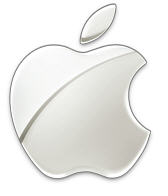 on a par with DVD release. The deals should rightly be interpreted as another step in the maturation of the broadband medium.
on a par with DVD release. The deals should rightly be interpreted as another step in the maturation of the broadband medium. However, these deals, in and of themselves, do not constitute a game-changing event for paid downloads of feature films. That's because until there's mass connectivity between PCs and TVs and much-improved portability, consumers' willingness to buy is going to be significantly muted. Consumers' inability to easily watch a feature film on their widescreen TV or easily grab-these- movies-to-go (as with DVDs) are a huge drag on the download value proposition, easily swamping its new convenience benefits.
I believe that lack of mass connectivity between PCs and TVs is the last major hurdle to unlocking broadband video's ultimate potential. It is also the firewall that's preserving a lot of incumbents' business models (cable operators, broadcasters, etc.). No question, Apple and iTunes are powerful marketing partners for the studios, and their download revenue will certainly increase from its current modest base. But not even Apple's mighty brand (and certainly not its anemic AppleTV device) is enough to compensate for broadband's current deficiency.
The good news is that there's a frenzy of energy directed at solving the PC-to-TV connectivity issue. Though no approach has yet broken through, I'm still betting it's only a matter of time until one does. When that happens, studios will reap the major benefits. Until then, these deals represent progress, but not game-changing events.
Categories: Aggregators, Downloads, FIlms, Studios
Topics: Apple, Disney, FOX, iTunes, Lionsgate, New Line, Paramount, Sony Pictures, Universal, Warner Bros.
-
YouTube: "Over-the-Top's" Best Friend
The announcement a couple of weeks ago that YouTube was partnering with TiVo got me to thinking that YouTube is probably the best friend that so called "over-the-top" or "cable bypass" aspirants could have.
As a quick refresher, "over-the-top" and "cable bypass" refer to the emerging category of devices and service providers seeking to bring broadband video to the consumer's TV, but without the involvement of existing video providers such as cable and satellite. Some of these efforts (Apple TV, Vudu and Internet-enabled TVs) are positioned as augmenting incumbent providers, while some (Building B, others) are meant to compete directly.
Today's players share the common trait of being closed, "walled gardens," offering only certain content that they select. This contrasts with the open Internet/broadband model, where users are able to access any content they choose. Many of you know that I have been a strong proponent that open is the winning competitive path for aspiring over-the-top players.
If the over-the-top crowd adopts the open approach, YouTube is their perfect ally; it is the best-known brand name in broadband video, has the largest library of both user-generated and increasingly premium
 video and has huge loyalty. Positioned properly it could be a killer value proposition for over-the-top players. I've previously argued that Apple missed the boat by not adopting this positioning for Apple TV.
video and has huge loyalty. Positioned properly it could be a killer value proposition for over-the-top players. I've previously argued that Apple missed the boat by not adopting this positioning for Apple TV.I talked last week with David Eun, VP of content partnerships at Google and Chris Maxcy, head of biz dev for YouTube, and they both made clear that the goal is to morph YouTube from a consumer destination site to a full-fledged video platform distributing video everywhere - devices, mobile, web sites, others. To this end, YouTube recently published an expanded set of APIs to allow 3rd parties to gain easier access to YouTube's content. This of course is great news for over-the-top devices, who should have considerable flexibility for how to incorporate YouTube into their offering. For now TiVo is leading the way in offering YouTube, albeit to a very small audience.
If you were wondering whether YouTube or Google itself will enter the device business, that seems unlikely. David and Chris were clear in saying that devices are not their core competency, and they'll leave it to others to decide how to implement the YouTube APIs and create and test various user experiences. Meanwhile with more premium content flowing into YouTube, its value as an over-the-top partner only increases.
What do you think? Post a comment!
Categories: Aggregators, Devices
Topics: Apple, Apple TV, Google, TiVo, VUDU, YouTube
-
3 Broadband Video Snippets to End the Week
Closing out another busy week, here are 3 diverse broadband video snippets that hit my radar in the past few days:
1. YouTube Drives the Political Newscycle
Back in December, in 6 Predictions for 2008, I suggested that "2008 is the year of the broadband presidential election." This seems to become more evident with each passing week. I find that particularly when watching cable news, YouTube's influence just keeps on growing.
For example, I'm a fan of "AC360" on CNN, which I try to catch at 10pm each night. This week the show was constantly replaying the YouTube videos of Rev. Jeremiah Wright that have dogged the Obama campaign. Conversely, a few weeks ago, Obama got a great tailwind from the massive attention paid to the viral "Yes We Can" music video sensation by will.i.am. That of course was on top of the earlier "Obama Girl" phenomenon. Separately, the McCain campaign just yesterday fired a campaign worker for posting a controversial video on YouTube about Obama and race. This too was covered on AC360 last night. Then of course there were the YouTube co-sponsored debates, offering video-based questions that were constantly replayed afterward.
The point of all this is that broadband video has turned election coverage upside down, making it incredibly hard for candidates to control the political newscycle. The "democratizing" effect of YouTube means that on any given day, at any given moment, something may get posted which diverts the campaign's attention. And with major media outlets paying such close attention to YouTube, everything is immediately amplified. Not since the early 1960s when TV began influencing presidential politics have we seen a new medium have such a profound impact on an election. And we still have 8 months to go until November...who knows what's yet to come!
2. SI Vault is Addictive
On to something more fun, if you haven't yet checked out Sports Illustrated's new "SI Vault" site just launched this week, I suggest you do. It's a highly addictive trip down memory lane. SI has digitized all of its assets and also made available non-SI content, all in one easy-to-use location powered by Truveo. Focusing on video, I found Franco Harris's "Immaculate Reception" from the 1972 Steelers-Raiders playoff game and also Doug Flutie's famous "Hail Mary" pass to beat Miami in 1984. I could have spent hours at the site, although it's not perfect. I tried finding Tom Watson's 1982 U.S. Open chip-in at Pebble Beach to beat Jack Nicklaus, but alas no results were found. Obviously all this stuff is available elsewhere online, but SI Vault creates a great context for sports fans to enjoy themselves, wrapping SI and non-SI content together in one nice package.
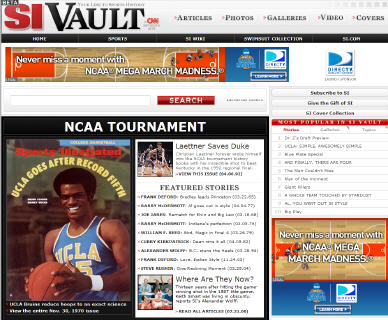
3. Apple's Roadblocks are Baaaack
And for even more fun, I encourage you to check out WSJ.com and NYTimes.com today. Apple is "roadblocking" the home pages of both again with a new Mac vs. PC ad, as they did back on Jan. 17th. This means that Apple has bought out all the home page leaderboard inventory on these 2 sites, so every time a visitor comes today, they see the same Apple ad. With all the talk about broadband video advertising, pre-rolls, overlays, etc, Apple again shows with its roadblocks how a little bit of creativity with rich media ad units can go a really long way. The ads are a great mix of interruption and opt-in and are no doubt highly effective branding units for Apple. Have a look and enjoy.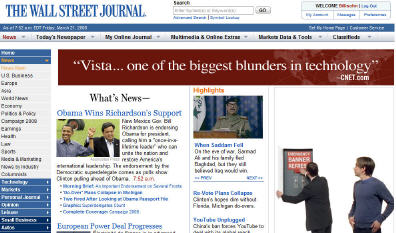
Categories: Brand Marketing, Cable Networks, Politics, Predictions, Sports, UGC, Video Sharing
Topics: Apple, Barack Obama, CNN, NYTimes.com, Sports Illustrated, Truveo, WSJ.com
-
Hurray for TiVo-YouTube
Hurray for TiVo and YouTube, which yesterday announced a partnership to allow certain TiVo users to watch YouTube videos on their TVs. While the actual number of homes which have the right TiVo model
 and have it connected to broadband numbers under a million, TiVo-YouTube shows there is still hope that the worlds of broadband video and TV will indeed converge.
and have it connected to broadband numbers under a million, TiVo-YouTube shows there is still hope that the worlds of broadband video and TV will indeed converge.Some of you will remember that in December '07 I wrote a post entitled "Broadband Video on TV is a Mirage" in which regrettably concluded that the mass availability of broadband video on TVs was nowhere on the horizon. In that post I wrote:
"The minority of consumers who will actually see broadband video on their TVs will either (1) shell out big bucks to buy a broadband appliance such as Vudu or Apple TV, (2) tackle the challenge of connecting their TVs via wireless networks (3) use a device built for another primary purpose, such as Xbox 360 or TiVo, to selectively augment their viewing with broadband-delivered choices or (4) use a service provider that has decided to throw in a few morsels of broadband video."
With the YouTube deal, TiVo continues to deliver on option 3, augmenting an already impressive array of broadband video available on select TiVo models. TiVo enhances its overall reputation for innovation
 (although still absent resounding market success or profitability), with a particular focus on broadband video. TiVo has previously offered up Amazon Unbox, TiVoCast, Music Choice, Home Movies, etc. Providing access to YouTube, the world's most popular video site, is another notable accomplishment for TiVo.
(although still absent resounding market success or profitability), with a particular focus on broadband video. TiVo has previously offered up Amazon Unbox, TiVoCast, Music Choice, Home Movies, etc. Providing access to YouTube, the world's most popular video site, is another notable accomplishment for TiVo.I continue to believe that whichever company cracks the code on how to deliver wide open broadband video access to the TV - coupled with a strong user experience - is going to hit it big. At the risk of looking too far backward, at the end of 2006 I conjectured that Apple's then still-to-be-launched Apple TV product could be a resounding success if it got the content strategy right (i.e. offering open broadband access and even focusing particularly on easy YouTube access through the device). Instead Apple TV has turned into yet another walled garden and to date has been a market failure. Apple continues to miss the open broadband market opportunity which is sitting right in front of it with a big bulls-eye plainly visible.
The TiVo-YouTube partnership will hopefully have the effect of accelerating the wake up call to other market participants that this gigantic opportunity awaits. Broadband video to the TV is a natural. It simply extends the cable/satellite model of the last 30 years: offering ever more video choices right to the TV.
As I've often said, as amazing as the growth curve has been for broadband video consumption over the last 5 years, even more amazing is that virtually all of this consumption has happened on the computer - a completely parallel world to the traditional TV viewing platform. Nobody could have imagined this level of consumer adoption for a non-TV viewing platform. So then look forward and imagine the possibilities when broadband video and the TV are fused for the masses.
Categories: Devices, Partnerships
Topics: Apple, Apple TV, TiVo, YouTube
-
"Mac vs. PC" Roadblocks on WSJ & NYT
Ending the week on a slightly lighter note, if you happened to go to WSJ.com or NYT.com yesterday, you would have seen that Apple bought out all the top of page ad inventory at both sites for its latest "Get a Mac" video spot (also known as the "Mac vs. PC" ads), which have been hugely popular on TV and online.
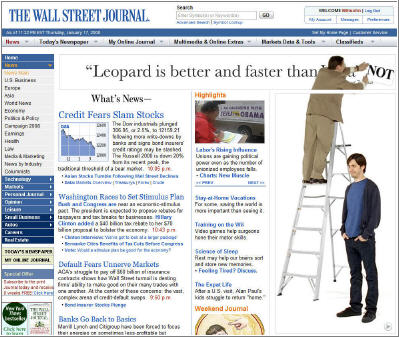
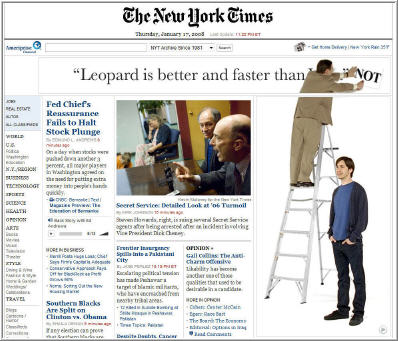
Apple's so-called "roadblock" strategy yesterday meant that every single visitor to these 2 sites were exposed to the same leaderboard/skyscraper video ad highlighting WSJ writer Walt Mossberg's opinion that Apple's latest Leopard OS release is "better and faster than Vista." Apple has a whole gallery of its "Get a Mac" ads here, though this new one is not yet posted.
In the online ad business, this type of video ad is referred to as "rich media." I haven't spent much time in VideoNuze discussing rich media ads, instead concentrating on pre-rolls and overlays ads which are actually adjacent to video content. Rich media ads show that there are many different ways to leverage video's emotional and informational impact even when there is no underlying video content to be adjacent to. Given the limitation of high-quality video content against which to run video ads, rich media has become an important and growing segment of the overall online ad business.
While, some rich media ads are way too "in your face" and spoil the user's experience, I think the way the yesterday's roadblock was executed is well within bounds. The video begins playing when the site loads, but the audio is muted. The user has to click the audio icon, and then the spot replays from the start. This means there's been an opt-in decision, which leads to higher engagement. Also, unlike many other rich media spots, the ad is composed solely of a leaderboard and skyscraper, so it doesn't have any obnoxious "pop-ups", "floating" or "expandable" components that block the underlying site content. These are the types of things that drive users crazy.
Rich media ads are an important part of the mix for fully understanding what's happening with video online, especially for advertisers who want to explore all options for leveraging video's emotional impact. I see the category continuing to grow. If ads are well-executed like Apple's, there will not only be minimal user pushback, but rather genuine opportunities for branding and interactivity.
Categories: Advertising
Topics: Apple
-
Apple TV Improves, Vudu is In its Crosshairs
As widely expected, yesterday Apple launched movie rentals in iTunes, with titles from all the major studios. Steve Jobs also announced price cuts and a number of key enhancements to Apple TV, squarely repositioning the device as a "broadband movies appliance" (my term). Apple TV now allows direct ordering (no computer needed) and a much improved UI prominently featuring movies. The message from Apple is
 clear: the primary value proposition for Apple TV's prospective buyers is convenient movie rentals through iTunes.
clear: the primary value proposition for Apple TV's prospective buyers is convenient movie rentals through iTunes. In the last few weeks there has been much buzzing about which companies might feel the most competitive pressure from Apple's launch of movie rentals. Here's how I see it: when rentals are combined with Apple TV's new features, the company that has to be waking up this morning most nervous about Apple's news yesterday is Vudu, because it has the most obviously similar value proposition.
Some of you may not be familiar with Vudu. It is a recently launched combination online movie/TV on demand service and companion box that has gained a lot of favorable early reviews. The company is backed by Benchmark and Greylock, two huge and highly regarded venture firms. While any startup faces long odds of success, with Vudu now going up against the Apple branding and marketing juggernaut, Vudu's odds
 seem even more daunting. In fact, one wonders how the folks at Benchmark and Greylock, when considering their original Vudu investment, weighed the very question of Apple's entry into this market, as it was somewhat inevitable.
seem even more daunting. In fact, one wonders how the folks at Benchmark and Greylock, when considering their original Vudu investment, weighed the very question of Apple's entry into this market, as it was somewhat inevitable.To step back for a moment, as many of you know, I'm skeptical about all appliances meant to bridge the broadband and TV worlds, as I think they have only narrow consumer appeal and create new inconveniences. Apple TV and Vudu are even more specifically-directed at people who are focused on premium movie and TV content, not gaining access to the wider world of broadband video (note Apple TV does provide some access to YouTube videos and podcasts). In effect, purchasers of either of these products value the instant viewing gratification they offer more than the selection, portability, unlimited viewing windows and "extras" that DVDs provide. And of course there are a broad array of choices and models for accessing DVDs (e.g. Netflix, Blockbuster, Wal-Mart, etc.).
However, for interested buyers, my sense is that both Apple TV and Vudu do an admirable job at delivering online movies and TV programs. The issue is that, if I was considering a purchase, and was obviously only going to buy one, I'd be hard-pressed to see why I'd pick Vudu over Apple TV. Consider: Apple TV is cheaper ($329 vs $399 for Vudu, albeit with smaller storage space), provides access to your music library and podcasts already configured in iTunes, allows easy display of your photos, has a familiar iPod/iTunes UI and enables transfers to these devices for portable viewing. Apple TV is also backed by a strong and well-known brand, giving additional comfort that the company will be around for a long time to come, which is always a nagging question when buying anything from a startup.
The whole category of broadband movie appliances is going to remain pretty small until the key limitations are resolved (small selection, 24 hour playback, 30-day expiration, no portability, no "extras", etc.). When these are fully addressed, online delivery of movies and TV programs will happen in a big way, no question.
So for now, given these limitations, what we're really seeing is a skirmish for positioning and branding, with an eye toward the long-term win. This dynamic in particular gives Apple, as a multi-billion dollar diversified company, yet another a big advantage over a single product startup. I've learned never to count out plucky startups, but given Apple TV's new positioning plus rentals, the mountain Vudu is trying to climb just got a whole lot more treacherous.
What do you think? Post a comment and let everyone know!
Categories: Aggregators, Devices, FIlms
Topics: Apple, Apple TV, iTunes, VUDU
-
Netflix-Apple Battle is Illusory
Netflix announced this morning that it was removing the usage cap on its "Instant Watching" feature for unlimited plan subscribers. This feature allows subscribers to choose from 6,000 titles (and growing) to stream and view on their PCs. Up until now subscribers received an allocation of streaming hours based on their monthly subscription level (e.g. 17 hours if subscribing at $17/mo). Now the hours will be unlimited. It's a smart move for Netflix and a great value proposition for Netflix subscribers.

AP first reported the change yesterday and is depicting it as a preemptive move against Apple, which is anticipated to announce tomorrow that movie rental downloads will be available in iTunes. The price point is expected to be $3.99/download. This is a major departure for Apple's iTunes, which has, of course, stuck religiously to its purchase download model for both music and videos.
Others have also depicted Apple's move as a direct strike at Netflix, but I think this battle is illusory. Rather, I view Apple's introduction of rentals as clear competition for the likes of Movielink, CinemaNow, Amazon
 Unbox, XBox LIVE and other rental stores, but not a blow to Netflix. The value propositions are very different. That's because Netflix very wisely has made the Instant Watching feature a value add for its subscribers, not an incremental fee.
Unbox, XBox LIVE and other rental stores, but not a blow to Netflix. The value propositions are very different. That's because Netflix very wisely has made the Instant Watching feature a value add for its subscribers, not an incremental fee. As a $16.99/mo subscriber myself, I love the fact that Netflix is unmetering Instant Watching, and am hard-pressed to see why anyone would drop their subscription in favor of Apple's rental model, unless they envision consuming a lot of movies on their iPods (now there's a slim segment of the population!).
From an economic standpoint alone, the breakeven is only 4+ movies, which is likely well below the monthly consumption of most of Netflix's full unlimited subscribers. And with Apple's rental model, users are still subjected to all the same online movie limitations all the other services have suffered from: no easy playback on TVs, lack of portability, viewing window limits, etc. Granted iTunes downloads enable watching on-the-go (vs. Netflix's streams), but I don't see that as a big differentiator. With Netflix you get the best of DVDs' advantages and now unlimited online delivery.
Now, if Apple were to pursue subscriptions, that would be a direct attack on Netflix. Yet even this approach might not be that successful. The fact is, Netflix has spent heavily on marketing over the years, and its strong brand awareness and 7 million subscriber base are quite meaningful advantages.
Online movie delivery, whether rental or owned, still has a long way to go to achieve mainstream success. Apple will certainly nudge the category forward, but not dramatically. Still, Netflix needs to remain aggressively on offensive to retain its leadership mantle. This is a category with lots of moves yet to be made.
Am I missing something? Post a comment and let everyone know!
Categories: Aggregators, Devices, FIlms
-
Here Comes the Video "Experience Era"
OK, one last post related to CES, and then I promise to shut up about the show.
Observing the goings-on this week, it is evident that both content and consumer electronics firms have come to the same basic conclusion: each industry's success is inextricably tied to the other's. Each recognizes that the business dynamics of the future requires a new way of differentiating their products than they are accustomed. That means, for example, that TV makers can no longer just boast about better pictures. And that content companies can no longer bank on bigger stars or funnier sitcoms to deliver audiences and profits.
Rather, both industries recognize that we are moving into what I would call the "experience era" for video. That's to say, success with consumers is going to rest more on these industries' ability to deliver superior experiences which integrate content and technology in new and compelling ways. Rather than oohing and ahhing about their new TV's picture quality or how hilarious a certain episode was, going forward consumers will increasingly cite "how cool" something is.
"How cool" are code words for "how compelling is the experience". The new currency of video hipness will require that when I invite friends to my house and want to show off, I need to have more than just a honking-big screen or a digital collection of old programs - those will be commonplace. Instead, the experiences are what will matter. Things like seamlessly accessing broadband content on my TV, interacting with it -- along with other viewers -- from my couch, and moving it around my house for playback anywhere, in a snap. Delivering these types of experiences (and more) is the new competitive bar that content and technology firms should be aiming for.
My sense is these industry executives know this, and the partnerships we saw unveiled -- and those yet to come -- demonstrate this recognition. Listen to what Bob Scaglione, Sharp's SVP Marketing said in this NY Times piece: "We already all have beautiful HD televisions. How do you differentiate? One way to provide some really unique differentiation is to provide new content. That's why we're fighting to find the right content providers."
And then what Beth Comstock, president of NBC Universal Integrated Media said: "You can't talk about consumer electronics without talking about content.....We try every new technology that comes along."
Executives across the content and technology spectrum must understand the experience era is now upon us. Steve Jobs and Apple's iPod ushered in the experience era in the music business. We now wait to see which companies in the video industry will do the same and reach for Apple's success. In a hyper competitive world, those who deliver strongly against consumers' needs and desires will be the ultimate winners in the experience battle now underway.
Agree or disagree? Post a comment and let us all know!
Categories: Broadcasters, Devices, Strategy
Topics: Apple, iPod, NBCU, Sharp
-
Holiday Week 2007 News Wrap-up
Happy New Year and welcome to 2008!
With many of you taking last week off, a quick review of what you might have missed is in order:
1. iTunes-Fox download-to-rent movie deal rumors
The FT (reg. required) reported that Apple and Fox are close to announcing a deal under which Fox movies would be available for download-to-rent on iTunes. This would be a deviation from Apple's policy of download-to-own only. Call me a skeptic, but while some analysts think this deal is a big breakthrough, for me it's more of a ho-hum, for at least the following reasons.
Download-to-rent offerings have been around for a while (e.g. Movielink, CinemaNow, Amazon Unbox, etc.) and none have been grand slams. Admittedly none have enabled playback on an iPod. Yet, while many think iPod ubiquity is a killer advantage for iTunes rentals I disagree. It's one thing to watch a 30 or maybe a 60 minute TV show, but watching a 2 hour movie on an iPod? That's only appealing for a tiny minority of iPod owners. Further, while the rumored $2.99 or so price point is attractive, download-to-rent movies will come with the same cumbersome business rules (e.g. 24 hour viewing, window limitations, finite device sharing, etc.) that cause significant customer inconvenience. And DVDs, available for rental or purchase still offer superior portability and flexibility to any download model. Movie downloads' time will come, just not yet.
2. Wal-Mart Folds its Video Download Store
And speaking of download challenges, Wal-Mart decided to unceremoniously close its video download store less than a year since its launch. While it pointed its finger at its vendor HP, which decided to discontinue support for the technology underlying the Wal-Mart store, there are certainly other white label platform alternatives available if Wal-Mart had conviction about the download store's potential. It clearly didn't and so it folded its tent. More evidence of the challenges facing paid downloads.
3. YouTube's Top 2007 Videos Announced
Meanwhile over in YouTube land, the hits keep coming. YouTube released its top 10 list and the year's most popular video, with almost 23 million views, was "Battle at Kruger", which shows the fight to save a baby water buffalo from a group of lions and a crocodile. It's fascinating if you haven't seen it. Other top videos on the list were "Chocolate Rain", "Obama Girl" and "Leave Britney Alone", among others. If nothing else, this diverse group of videos shows that UGC is alive and well.
4. Queen Elizabeth and Roger Clemens Seek Out YouTube
And UGC wasn't for pure amateurs either. YouTube's reach was once again recognized as 2 celebrities, Queen Elizabeth and Roger Clemens posted videos serving their individual purposes. In a first for the 81 year-old queen, she posted her popular Christmas message on YouTube, augmenting its traditional broadcast. The Royal Channel - "The Official Channel of the British Monarchy" - also launched on YouTube.
Clemens, who's been fingered in baseball's steroid controversy, saw fit to post his proclamation of innocence on YouTube. Clemens is adamant in his own defense, and clearly believes that reaching out to fans with video instead of the usual press release is more compelling.
Trivia question: whose video do you think drew more views?
Answer: It's not even close: 741,000 for the queen vs. 274,000 for Clemens.
5. MTV Delivers 1.2 Billion Streams in '07
MTV self-reported that MTV.com, VH1.com and CMT.com delivered more than 1.2 billion video streams in '07, an increase of 30% vs. '06. It also reported the top 30 music videos it streamed, and number 1 was Gimme More by Britney Spears. Broadband is offering MTV an opportunity to return to its brand roots as the go-to destination for music videos even as more and more of the on-air experience is dominated by non-music video fare. As I wrote a couple months ago, music videos are becoming a sought-after new revenue stream for labels and aggregators. We'll see more emphasis on music videos in '08.
Categories: Aggregators, Cable Networks, Downloads, FIlms, Music, UGC
Topics: Apple, FOX, HP, iTunes, MTV, Wal-Mart, YouTube
-
Broadband Video on TV is a Mirage
In yesterday's WSJ, Nick Wingfield wrote a lengthy article outlining the 5 key challenges encountered by the myriad devices aimed at bringing broadband video to TVs. He lists them as: consumer resistance to adding another box, complications in setting them up, cost, lack of content and slow downloads.
The article has a generally optimistic tone, posing "solutions" to each of the challenges. You're left with the impression that mass-scale broadband video on TV could actually happen sometime soon.
At the risk of being the "skunk at the picnic," I have recently come to believe that broadband video on TVs is a mirage, tantalizingly close yet in reality nowhere on the horizon. Unless there is some new box or approach I've yet to hear about, I've regrettably concluded that broadband video will be tied to computers, and select mobile devices, for a long time to come.
The minority of consumers who will actually see broadband video on their TVs will either (1) shell out big bucks to buy a broadband appliance such as Vudu or Apple TV, (2) tackle the challenge of connecting their TVs via wireless networks (3) use a device built for another primary purpose, such as Xbox 360 or TiVo, to selectively augment their viewing with broadband-delivered choices or (4) use a service provider that has decided to throw in a few morsels of broadband video.
Those of you with good memories will remember that in a Broadband Directions newsletter at the end of 2007 I wrote bullishly about Apple TV's ability to become the breakout convergence device, if only Apple opened up the box to all broadband content. Instead Apple has kept the box closed, available for iTunes downloads and selected YouTube videos. Consequently it has been a flop.
To help explain why products succeed or not, I tend to reach for Prof. Clayton Christensen's abiding lesson that people "hire" products to do "jobs" they have to be done. In other words, products that meet the buyer's true desires are the ones that succeed.
For me, the "job" that consumers increasingly want "done" is to be presented with an integrated, easy-to-access service (not just a new box) that offers all video programming they value in an on-demand manner and priced appropriately. That's a tall order, but ultimately one which will drive wide-spread success of any new product in this space.
Some of the possibilities include TiVo, which believes in this "seamless" philosophy, though it is still dependent on current service providers (cable, satellite, telco) to deliver programming. ICTV has a very interesting approach, though it is also reliant on existing service providers. Building B is taking a bold approach that seems to meet the full test for success, though it's still too early to know whether they can successfully execute on their vision.
But hodge-podge, costly broadband appliances just create new inconveniences while only partially addressing true consumer needs. As a result, they're not going to find a broad market. And so, barring some other new innovation, most of the world will still be watching broadband video on their computers and some mobile devices for a long time to come.
Categories: Devices
Topics: Apple, Apple TV, Building B, ICTV, TiVo, VUDU
-
Sansa TakeTV + Fanfare Should Have Stocking Stuffer Appeal
Today SanDisk officially announced its "Sansa TakeTV' USB PC to TV device, which is married to its "Fanfare" digital download store. As "convergence devices" go, this is about as straightforward as it gets. Fanfare is still pretty lean on content, but that will no doubt change quickly.
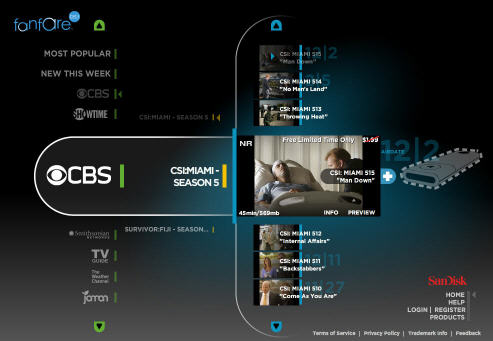
I saw an early version of this product at the NAB Futures Summit last April (CNET's Brian Cooley brought one along) and for simplicity it's hard to beat. You download the Fanfare software (a snap), plug the device into your USB, download files, and then plug the device into its cradle, which is connected to your TV. What I haven't seen is the UI for the TV, so I can't comment on that.
Considering I witnessed my 8 year-old nephew figure out how to plug his digital camera into his TV to do slide shows, I'd expect Sansa TakeTV to appeal to a pretty wide audience of non-techies. And at $100 for the 4GB model (saves about 5 hours of video), it's a solid "stocking stuffer" for the upcoming holiday season.
Sansa TakeTV is another example of the limitless innovation underway to converge the PC/broadband video world with the TV world. To date most of the solutions here (except AppleTV and Xbox probably) have been pretty techie, requiring some degree of user intervention to marry the PC and the TV over the home wireless or wired network. It's safe to say that none of these devices has yet caught on.
Sansa TakeTV's issue is whether it can be anything more than a short term, low end solution. A lot of the answer is wrapped up whether USB Flash storage can scale up to inexpensively handle lots of video. For example, the low-end AppleTV holds 40 GB and costs $299, while the 16GB USB Flash drives I found online approach $200 alone, never mind the software and other component costs in the Sansa Take TV package. (see below).

However, if anyone's going to figure out how to make USB Flash storage competitive for video, it'll be SanDisk. In the meantime, there's nothing wrong with accepting Sansa Take TV for what it is - an easy-to-use, low end product for the masses to watch high-quality broadband video on their TVs.
Categories: Devices
Topics: Apple, AppleTV, SanDisk, TakeTV
-
Broadband Video vs. IPTV, The Differences Do Matter
It's funny how often I'll be talking to someone and they will casually start interchanging the terms "IPTV" and "broadband video/online video/Internet TV".
The fact that many people, including some that are actually well-informed, continue doing so is a reminder of how nascent these delivery platforms still are, and how common terms of use and understandings have yet to be established.
Yet it's important to clarify that there are differences and they do matter. While some of the backend IP transport technology is common between IPTV and broadband video, the front end technology, business models and content approaches are quite different.
In presentations I do, I distinguish that, to me at least, "IPTV" refers to the video rollouts now being pursued by large telcos (AT&T, etc.) here in the U.S. and internationally. These use IPTV-enabled set-top boxes which deliver video as IP packets right to the box, where they are converted to analog video to be visible to the viewer. IPTV set tops have more capabilities and features than traditional MPEG set-tops, and telcos are trying this as a point of differentiation.
However, at a fundamental level, receiving IPTV-based video service is akin to subscribing to traditional cable TV - there are still multi-channel tiers the consumer subscribes to. And IPTV is a closed "walled garden" paradigm - video only gets onto the box if a "carriage" deal has been signed with the service provider (AT&T, etc.). IPTV can be viewed as an evolutionary, next-gen technology upgrade to existing video distribution business models.
On the other hand, broadband video/online video/Internet TV (whatever term you prefer) is more of a revolutionary approach because it is an "open" model, just like the Internet itself. In the broadband world, there's no set-top box "control point" governing what's accessible by consumers. As with the Internet, anyone can post video, define a URL and quickly have video available to anyone with a broadband connection.
The catch is that today, displaying broadband-delivered video on a TV set is not straightforward, because most TVs are not connected to a broadband network. There are many solutions trying to solve this problem such as AppleTV, Microsoft Media Extender, Xbox, Internet-enabled TVs from Sony and others, networked TiVo boxes, etc. Each has its pros and cons, and while I believe eventually watching broadband video on your TV will be easy, that day is still some time off.
Many people ask, "Which approach will win?" My standard reply is there won't be a "winner take all" ending. Some people will always prefer the traditional multichannel subscription approach (IPTV or otherwise), while others will enjoy the flexibility and features broadband's model offers. However, for those in the traditional video world, it's important to recognize that over time broadband is certainly going to encroach on their successful models. Signs of change are all around us, and many content companies are now seizing on broadband as the next great medium.UPDATE: Mark Ellison, who is the SVP of Business Affaris and General Counsel at the NRTC (National Rural Telecommunications Cooperative, an organization which delivers telecom solutions to rural utilities) emailed to clarify that it's not just LARGE telcos that are pursuing IPTV, but many SMALLER ones as well. Point well taken Mark, it was an oversight to suggest that IPTV is solely the province of large telcos like AT&T.Categories: Cable TV Operators, IPTV, Technology, Telcos
Topics: Apple, AppleTV, Media Extender, Microsoft, Sony, TiVo, XBox
-
YouTube + Apple TV = A New Consumer Experience
Some pretty big news today from Steve Jobs that YouTube video will be embedded in directly AppleTV.Back in December '06, in my "7 Broadband Video Trends for 2007" e-newsletter, my #1 trend was that Apple's "iTV' box (as it was code-named then) would succeed - but only if Apple nuked its walled garden, iTunes/paid-only content strategy, in favor of allowing easy browsing of free online video. Though it would represent a big departure for Apple, I suggested the killer deal would be to make YouTube videos available to Apple TV users. (read the full entry below and here) True to its roots, Apple did launch Apple TV only with iTunes.And as it has floundered, I've taken plenty of flack from readers reminding me that these 3rd party, standalone boxes don't have a prayer. And that's why today's YouTube deal is a huge step in the right direction for Apple TV. YouTube is the big guerilla of all online video sites. But as big as it is, its use has mainly been constrained to computer screens. So by enabling easy viewership on TVs, Apple has created a whole new consumer experience, which I believe will prompt new buyers of Apple TV.And as Apple embeds more video sites (hey wouldn't it be easier if they just put a browser in Apple TV?), the proposition for box keeps getting stronger. This "over-the-top" or "cable bypass" approach should be another wake up call for cable and satellite operators. There is so much energy being invested in these alternative approaches (e.g. Xbox, TiVo, Sony, Netgear, etc.) that eventually some segment of consumers is just going to drop their traditional subscriptions and go a la carte. My original entry is below from December 20, 2006.All the 7 Trends for 2007 can be read here. -------------------------------------------------------------------------------------- "Apple's iTV box will likely succeed (but only if more than just iTunes video is easily accessible). This is clearly my most controversial prediction and the one I will devote the most ink to. Let me stipulate upfront - standalone appliances like these are indeed the "third rail" of consumer electronics. I understand all the reasons why they don't succeed. And the list of failures is long and undistinguished. However, my bet is that is that if ever a company stood a chance of succeeding and a box potentially met a clear consumer need, it is Apple and iTV. (by the way, "iTV" is just a code name, expect a new name prior to launch). Apple's user-centric design, functionality and coolness quotient are its key differentiators.First, for those of you who missed it, back in September Steve Jobs pre-announced the company's "iTV" box (see it here). Product pre-announcements are very rare for Apple. iTV's suggests that Jobs wanted to both lay some pre-launch buzz groundwork and also simply couldn't contain his enthusiasm for this product's market opportunity. To understand iTV's market opportunity, it is necessary to understand current broadband-delivered video viewership.As I see it, the amazing ramp up in broadband video consumption this year is surpassed by an even more amazing fact - that virtually all of this viewership has occurred on users' computers. Think about it - virtually all those clips, full-length programs and movies are consumed on the PC, not the TV! Nobody could have predicted that. But of course the TV is still the preferred viewing device for just about everyone. So logic suggests that if someone could make an affordable, easy-to-install box that unshackled users from their computers, allowing them to easily bridge the PC/broadband world with the TV, there would be a market for such a product. And that this could be far more than a niche opportunity, given that it could potentially disrupt cable and satellite operators' set-top box/walled garden stronghold.iTV's success turns on one key factor: Apple's content strategy for the product. And the hitch in iTV's potential is that to date Apple's content model has been to aggregate paid-only media in iTunes, its digital download store. The company has gotten off to a decently strong start selling TV programs and the like on an a la carte basis for $1.99 or more. But carrying over this paid approach is not a strong enough content strategy to support iTV.In fact, in the music world, a recent Ipsos study showed that only 25% of MP3 owners use fee-based download services. That's been OK for iPod sales because many people still have large CD collections (or share theirs with friends), which can be easily "ripped" to iPods. But what would the equivalent source of video content be to support iTV? Possibly DVDs, though converting them for iPod use is far from a mainstream activity (plus, why bother anyway?). How about the free video podcasts from a Byzantine array of providers also available through iTunes? Doubtful. Quite simply, if Apple extends its iTunes paid approach to iTV it would be forcing iTV buyers to pay for each and every incremental piece of video content to get value out of their iTV purchase. The number of people willing shell out $299 for an iTV box without readily available free content is tiny.Therefore, the alternative - providing easy TV-based viewing of free, ad-supported broadband video - should be iTV's core value proposition. Cracking this nut allows Apple to break open the video distribution value chain, with consumers finally getting TV-based access to the content they love. And it positions iTV as the key building block in making "long tail" video content accessible on TVs, potentially setting up Apple as a longer-term competitor for all video services (i.e. a possible competitor to cable and satellite).Exactly what content should be easily available through ITV is less clear to me. Certainly a key selection criterion is video that is either NOT currently available through cable or satellite. Many video content providers still dreaming of becoming a digital cable channel would salivate at the opportunity to be accessible on consumers' TVs. Plus broadcast and cable TV networks would love a way to get their broadband-only webisodes and other "broadband channels" all the way to the TV.But the most tantalizing content deal would be one with Google/YouTube. Consider how many YouTube devotees would love to get convenient access to this content right on their TVs. Since Apple has no in-house advertising skills and assets, and Google is the reigning advertising king, a partnership would be mutually beneficial. With Eric Schmidt, Google's CEO, now on Apple's board of directors, the personal relationship between he and Jobs would help clear the way for a deal.Packaging and offering easy access to ad-supported video would be a big content strategy departure for Apple, but a necessary one for iTV to fully flourish. Remember, selling hardware is what Apple's really all about. Given Apple's famous appetite for secrecy, I expect we'll only find out how Steve Jobs has decided to play his hand upon iTV's official launch. If it's to be iTunes-only paid video, I'll downgrade iTV's likelihood of big-time success considerably. "Categories: Devices, Partnerships, UGC
-
Mossberg Raves About AppleTV, But….
Pretty gushy review today from Walt Mossberg at the WSJ regarding his 10 day experience with AppleTV. I originally offered my opinions on AppleTV's prospects (then called "iTV") back in my December '06 newsletter ("7 Broadband Video Trends for 2007"). I thought AppleTV was likely a winner, but contingent on its content strategy. If it offered buyers access to iTunes content only then its appeal would be much more limited than if it opened up the box to all broadband video sources.
When Steve Jobs offered more details in his Macworld keynote I downgraded my enthusiasm, as they chose the former content strategy, precluding (for now) AppleTV's role as THE bridge between PC/broadband and TV. Walt reiterates this point ("Apple TV's most important limitation is that it can't stream much video or audio directly from the Internet -- yet.") but hints that this capability will be available in gen2 boxes.
I reiterate my opinion - for now AppleTV is ultracool, but will likely find only a limited audience to fork over $299 mainly to watch iTunes content on their TVs, plus manipulate music and photos. When AppleTV allows easy access to the rest of the world of broadband video, then it's going to be a big hit.
Categories: Deals & Financings
-
Wildstrom and I Agree on AppleTV
Stephen Wildstrom, who writes the "Technology and You" column in BusinessWeek echoes a point this week ("AppleTV's Blurry Future") about AppleTV that I made back in my 12/06 e-newsletter ("7 Broadband Video Trends for 2007"). At that time I suggested that for Apple's device to be a real winner, it needed to embrace a content strategy that was open to all broadband video, not just limited to what's available in iTunes.
Wildstrom similarly highlights this point. For now, AppleTV is a niche product, appealing only to those consumers ready to spend $300 to get iTunes video to their TVs. The big win for Apple would be to have a box that is easily capable of playing the 99% of video consumed daily that is not available in iTunes. That's what consumers are craving - an easy way of watching broadband video in the comfort of their living rooms. My guess is Apple knows this and will soon offer this feature as well.
Categories: Devices
Posts for 'Apple'
Previous |



